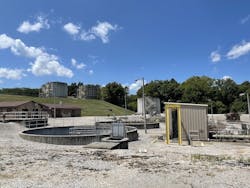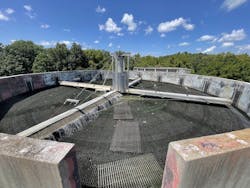Plant Profile: Perryville Waste Water Treatment Plant
About the author:
Carol Brzozowski is a freelance writer for Water & Wastes Digest. Brzozowski can be reached at [email protected].
Like many municipalities in the U.S., Perryville, Missouri, faces challenges due to aging wastewater infrastructure. It is a problem brought to light by the American Society of Civil Engineers (ASCE), which has given the nation’s more than 16,000 wastewater treatment plants a D+. Overall, plants are functioning at 81% of their design capacities, while 15% have reached or exceeded it. Growing urban environments serving as a driving factor. ASCE estimates utilities spent more than $3 billion in 2019 – more than $18 per wastewater customer – to replace the almost 4,700 miles of pipeline nationwide.
Perryville’s wastewater treatment facility serves nearly 9,000 residents and is a trickling filter plant consisting of a mechanical bar screen, grit washer, primary clarifiers, secondary clarifiers, three trickling filters, excess flow basin, tertiary filer, ultraviolet system and biosolids tanks.
The facility is operated in compliance with the regulations of the Missouri Department of Natural Resources and the U.S. Environmental Protection Agency. The plant currently employs two class A operators, three class B operators, and one class “C” operator.
Keeping up with the aging plant has presented challenges, according to Jeremy Meyer, director of water and wastewater operations.
“There are certain things that cost what they cost,” he adds. “If a pump goes down, you may try some innovative solutions for a repair that may last you for a while that’s a little cheaper than something new, especially when a new plant is coming or a few years away. You just don’t want to throw money away and buy something new.”
While the nationwide annual water infrastructure capital investment gap was $81 billion in 2019, the wastewater sector has made strides to address current and future needs through resilience-related planning and innovations that produce profitable by-products or cost savings from wastewater treatment.
“We’re building an entire new treatment plant,” Meyer said. “Our plant is almost 50 years old. The other part of our plant that was done in the ‘90s is 26 years old. Equipment doesn’t last forever. Most of the larger equipment in a wastewater plant may have a 20-year lifespan.
“There’s no way for us to meet future regulations and have the occasional violation and hiccup. With our current plant being outdated and showing its age, there’s no way it would even handle the future growth of our town.”
While the plant is not at the point where discharges to the creek are nearing concern, it would be a big issue in the future, Meyer said.
“This will allow our town to grow. And instead of just spending money fixing up the outdated stuff, the cost of a new plant is considerably better than rehabbing the really old outdated biological process as well.”
The current facility was put into operations in 1976 with a flow capacity of 100,000 gallons per day. Since then, the plant has undergone three major upgrades in 1984, 1997 and 2006 and has doubled its capacity. The system has cast iron and ductile iron pipe. An asphalt trunk line was replaced a year and a half ago. There also are sealed plastic lines inside the plant.
Its maximum capacity is now 1.8 million gallons per day (mgd) with the current daily flow average of 1 mgd of influent wastewater taken in through nearly 4,000 connections and a peak daily flow of about 7 to 9 mgd.
As waste flows through the system and enters the facility, it is screened for solid waste that may interfere with pumps and treatment. It then flows to a grit removal system, where the grit is removed to prevent it from damaging a pump or accumulating in the basins.
From there, it goes to two primary clarifiers to settle out as many solids as possible, reducing the need for treatment “so you don’t have to have such a big footprint for a plant.” Then the solids are pumped up to a sludge holding tank.
“The effluent off of those two primaries goes to a pump station which pumps to our trickling filters, which essentially is like the same thing you would see in a creek where the slime, bacteria and organisms are growing on rock – the water flows over those as it treats the water. It’s the same concept that’s been around for millions of years.
“From there, the effluent from the trickling filters goes to two final clarifiers, which settle out any remaining solids and then that effluent goes through a sand filter to clean it up a little bit more and then it goes through a UV system to disinfect for pathogens and is discharged to the creek.”
Perryville expected to break ground on the new project during September, with an anticipated completion in November. Giving plant tours to the public helps develop a greater understanding for the cost of the process, Meyer added.
“When they take a tour of a wastewater plant, they get a chance to see firsthand how time can affect things and how wastewater is corrosive,” he points out. “You put those two things together and it makes for some premature wearing. Sometimes people don’t realize what that equipment costs. If they come out and take a look at it, they can get a whole new grasp of what actually goes into the water when you open your faucet or where it goes when you flush the toilet.”
Another challenge Perryville is facing is industry-wide: finding qualified workers. While current employees have longevity at the plant, Meyer is expecting a few retirements and will need to fill those slots. Meyer has been researching various approaches and may borrow an idea from tech companies.
“They create laid-back environments,” he points out. “It’s going to have to be not what can we do to make this a fun place to work, but a good place to work where they want to come to work every day. We’re going to have to figure out something.”
About the Author
Carol Brzozowski
Carol Brzozowski is a freelance writer for Wastewater Digest. Brzozowski can be reached at [email protected].

